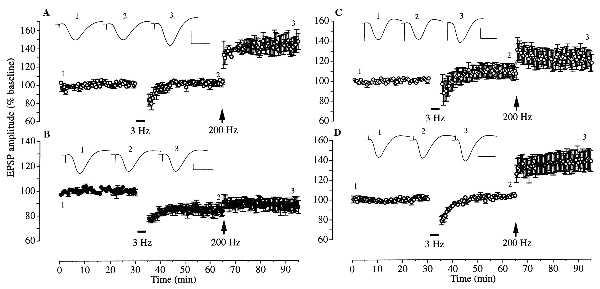Figure 2.

Blocking effects of RNA and protein synthesis inhibitors on the redirection of synaptic plasticity by behavioral stress. (A) Injection with the translation inhibitor emetine (240 μg, i.c.v.) 40 min after anesthesia (i.e., about 120 min before low frequency stimulation) blocked the effect of stress on both LTD and LTP induction (n = 4). Low frequency stimulation failed to induce LTD. Subsequent high frequency stimulation induced significant LTP, a magnitude not significantly different from that observed in nonstressed controls. (B) The same dose of emetine given 15–30 min before low frequency stimulation (≈130 min after stress) failed to affect the effect of stress on synaptic plasticity (n = 4). LTD was induced by low frequency stimulation and subsequent high frequency stimulation failed to induce LTP. (C and D) Actinomycin D (60 μg, i.c.v.), a transcription inhibitor, was given 40 min after anesthesia (i.e., about 120 min before low frequency stimulation). In stressed animals (C) low frequency stimulation failed to induce LTD. Subsequent high frequency stimulation did not induce significant LTP. In the nonstressed rats (D) low frequency stimulation failed to induce LTD and subsequent high frequency stimulation resulted in significant LTP (n = 5). (Insets) Representative traces of field potentials at the times indicated by the numbers on the graph. Horizontal bar = 10 ms. Vertical bar = 1 mV.
